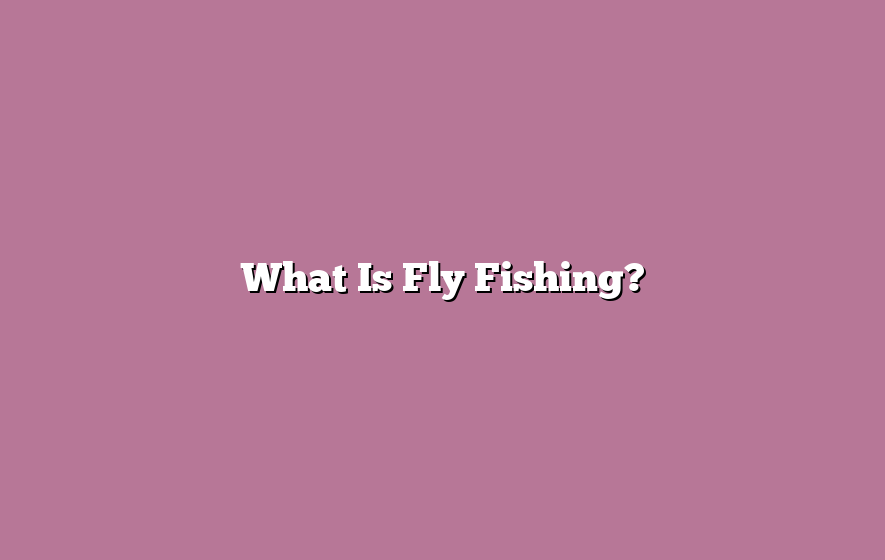Fly fishing is an exciting and rewarding angling technique that has captivated the hearts of fishing enthusiasts for centuries. Unlike traditional fishing methods that rely on bait or lures, fly fishing involves the use of artificial flies made from feathers, fur, and other materials to entice fish to bite. In this comprehensive guide, we will delve into the world of fly fishing, exploring its basics, history, techniques, equipment, and more.
Fly fishing is much more than just catching fish; it’s an art form, a way of connecting with nature and challenging oneself. It requires patience, skill, and an understanding of the aquatic ecosystem. Whether you are a seasoned angler or a beginner looking to explore a new hobby, fly fishing offers a unique and fulfilling experience.
The Basics of Fly Fishing
To engage in fly fishing, you need to understand the basics. This includes learning about fly rods, reels, lines, leaders, and tippets. We’ll discuss the different components and their functions, helping you choose the right gear for your needs and budget.
The History of Fly Fishing
Fly fishing has a rich history that dates back thousands of years. From its origins in ancient Egypt and China to its modern-day popularity, we’ll explore the evolution of fly fishing techniques, equipment, and philosophies.
Equipment Needed for Fly Fishing
In this section, we’ll delve into the essential equipment needed for fly fishing. From fly rods and reels to lines, leaders, and accessories, we’ll provide detailed insights into each component and offer tips for selecting the right equipment based on your fishing goals.
Different Types of Flies
Flies are the heart and soul of fly fishing. We’ll introduce you to various types of flies, including dry, wet, nymphs, streamers, and terrestrials. Each type of fly is designed to imitate a specific insect or baitfish, and we’ll discuss when and how to use them effectively.
Fly Casting Techniques
Mastering fly casting is essential for successful fly fishing. We’ll cover the basic casting techniques such as overhead cast, roll cast, and reach cast, providing step-by-step instructions and practical tips to help you improve your casting skills.
Choosing the Right Location for Fly Fishing
Finding the perfect fishing spot is crucial. We’ll guide you through the process of selecting the right location based on factors such as water type, fish species, weather conditions, and accessibility. Whether you prefer rivers, lakes, or saltwater, we’ll help you find your ideal fly fishing destination.
Understanding Fish Behavior
To become a proficient fly angler, it’s essential to understand the behavior and feeding patterns of fish. We’ll explore the underwater world of fish, discussing their habitat preferences, feeding habits, and how to read the water to increase your chances of success.
Fly Fishing Tips and Tricks
In this section, we’ll share valuable tips and tricks that will enhance your fly fishing experience. From selecting the right fly for specific conditions to improving your presentation and detecting strikes, these practical insights will help you become a more skilled angler.
Fly Fishing Conservation
Fly fishing and conservation go hand in hand. We’ll highlight the importance of practicing catch-and-release, respecting fishing regulations, and being mindful of the environment. We’ll also discuss various conservation organizations and initiatives dedicated to preserving fish habitats.
Fly Fishing as a Recreational Activity
Beyond its angling aspect, fly fishing offers numerous recreational benefits. We’ll explore how fly fishing can reduce stress, foster mindfulness, and provide opportunities for relaxation and self-reflection in nature’s tranquil settings.
Fly Fishing Competitions
For those seeking a competitive edge, fly fishing competitions offer a platform to showcase skills and compete against fellow anglers. We’ll delve into the world of fly fishing tournaments, including the different formats and techniques employed by competitors.
Fly Fishing Destinations
From remote mountain streams to famous rivers and exotic saltwater flats, the world is full of incredible fly-fishing destinations. We’ll take you on a virtual tour of some renowned fly fishing hotspots, discussing their unique features and the fish species they offer.
Common Fly Fishing Mistakes to Avoid
Even experienced fly anglers make mistakes. We’ll highlight common pitfalls and blunders that can hinder your success and provide practical advice on how to avoid them. Learning from others’ mistakes will save you time, and frustration, and increase your chances of landing that trophy fish.
Conclusion
Fly fishing is a captivating pursuit that combines skill, artistry, and a deep connection with nature. As you embark on your fly fishing journey, remember to cherish the experience, respect the environment, and continue learning and honing your angling skills. So grab your gear, tie on a fly, and immerse yourself in the world of fly fishing.
FAQs
- Can anyone try fly fishing, or is it only for experts? Fly fishing is suitable for all skill levels, from beginners to seasoned anglers. With practice and patience, anyone can learn and enjoy the art of fly fishing.
- Do I need a lot of expensive equipment to start fly fishing? While fly fishing equipment can range in price, you can find affordable options suitable for beginners. As you progress and develop your skills, you can invest in more advanced gear.
- What is the best time of year for fly fishing? The best time for fly fishing varies depending on the location and the target fish species. Researching the local fishing seasons and consulting local guides will help you plan your fishing trips accordingly.
- Is fly fishing only for freshwater, or can it be done in saltwater too? Fly fishing is versatile and can be practiced in both freshwater and saltwater environments. Saltwater fly fishing offers the thrill of catching species like bonefish, tarpon, and permit.
- Is fly fishing a sustainable fishing method? When practiced responsibly with catch-and-release principles and adherence to fishing regulations, fly fishing can be a sustainable angling method that minimizes harm to fish populations and their habitats.

